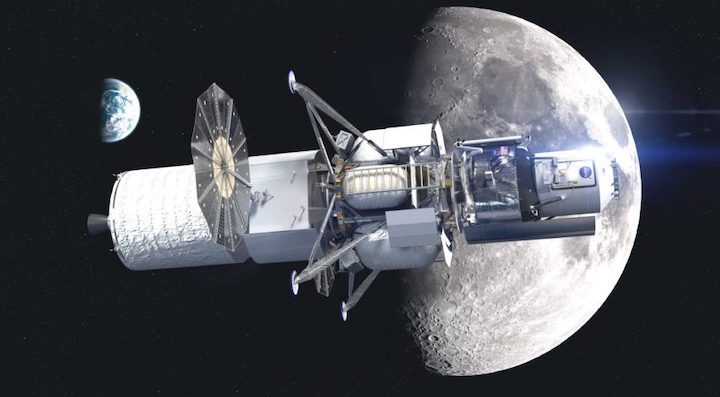1.04.2022

WASHINGTON — Northrop Grumman says it’s still considering whether to rejoin a Blue Origin-led team for a second Artemis lunar lander competition or to go on its own.
In a media briefing March 30 about the company’s overall contributions to the Artemis program, executives said they were “encouraged and excited” about NASA’s plans to procure a second lander through the new Sustaining Lunar Development effort announced March 23. That lander will join the one being developed by SpaceX and based on its Starship vehicle through Option A of the Human Landing System (HLS) program.
Northrop Grumman competed for the original HLS award as part of a “National Team” led by Blue Origin that also included Lockheed Martin and Draper. Northrop’s role in that effort was to provide a transfer element that would transport the lunar module from the Gateway to low lunar orbit.
Rick Mastracchio, director of business development for human exploration and operations at Northrop Grumman, said the company was interested in the new competition but had not decided its strategy for it. “As a result of this recently announced NASA plan, the company is now finalizing our plans for how we’re going to participate,” he said.
That could include, he said later, rejoining the Blue Origin-led effort or by leading its own proposal. “We’ve done our own studies on the Human Landing System and we’ve worked with the National Team and Blue Origin,” he said. “Right now we’re in the decision-making process on that, and hopefully that will be a decision that comes out in the next few weeks.”
He noted that Northrop Grumman has worked on its own lunar lander concepts for some time, supported by a series of NASA awards. The company won $34.8 million in September 2021 to support work on “sustainable” lunar lander concepts through a NASA effort formally known as Next Space Technologies for Exploration Partnerships (NextSTEP) Appendix N.
“Through all of these efforts, Northrop Grumman has made significant progress in technology maturation and mission risk reduction related to these landers,” Mastracchio said, citing the Appendix N and earlier awards.
At the time of that award last September, Northrop appeared to leave the door open to competing on its own in the future. Steve Krein, vice president of civil and commercial space at Northrop, said in a statement that, in addition to its role on the National Team, “we are also providing our unique skills and capabilities to exploring alternative perspectives for a long-term sustainable program to take humans back to the moon to stay.”
Lockheed Martin, which won a $35.2 million Appendix N award at the same time, offered a similar perspective. “As a long-standing and trusted NASA partner, we also believe it is important to provide additional approaches to help shape the strategy for both a sustainable human presence on the moon and also future human missions to Mars,” Lisa Callahan, vice president and general manager of commercial civil space at Lockheed Martin, said in a statement at the time of the Appendix N award.
NASA has not provided additional details about the Sustaining Lunar Development, also known as NextSTEP Appendix P, since the March 23 announcement. At the time, the agency said it would release a draft request for proposals by the end of March and hold industry days in early April. The final request for proposals would follow later in the spring.
NASA requested nearly $1.5 billion for the overall HLS program in its fiscal year 2023 budget proposal March 28. However, agency officials declined to state how that funding would be allocated between the new lander effort and the existing Option A HLS award to SpaceX.
Cygnus flexibility
Northrop executives also used the briefing to address the uncertainty about the future of its Antares launch vehicle, which it uses to launch Cygnus cargo spacecraft to the International Space Station. That rocket uses a first stage produced in Ukraine and powered by a Russian RD-181 engine, both of which could no longer be available because of Russia’s invasion of Ukraine and subsequent sanctions.
Sarah Schellpfeffer, space systems sector vice president and chief technology officer at Northrop, confirmed at the briefing that the company has all the Antares hardware needed for the next two missions, NG-18 and NG-19, which would take the company into 2023.
“Since Cygnus is designed to be compatible with a range of launch vehicles, we continue to review options to provide the best service, performance and price for future missions,” she said. She didn’t elaborate on those options, including the possibility of replacing the RD-181 with an alternative engine.
After an Antares launch failure in 2014, which led then-Orbital Sciences to replace the AJ26 engines originally used on the rocket with the newer RD-181, the company launched two Cygnus missions on United Launch Alliance Atlas 5 rockets. However, all the remaining Atlas 5 rockets have been sold to other customers, and its replacement, the Vulcan Centaur, has yet to make its first flight.
Despite the launch uncertainty, NASA awarded Northrop Grumman March 25 six additional Cygnus cargo missions to the ISS under its Commercial Resupply Services (CRS) 2 contract awarded in 2016. NASA has now ordered 14 Cygnus missions through its CRS-2 contract.
NASA, which also awarded SpaceX six additional Dragon cargo missions under its CRS-2 contract at the same time, declined to state the value of the new awards. NASA spokesperson Sandra Jones said March 25 that the agency could not do so since they were orders under indefinite-delivery, indefinite-quantity (IDIQ) contracts. “Typically, orders made as a result of IDIQ competitions are not publicized,” she said. “Additionally, much of the pricing information is contractor confidential data.”
Neither Northrop Grumman nor SpaceX responded to requests for comment about the value of their new CRS-2 missions.
Quelle: SN
